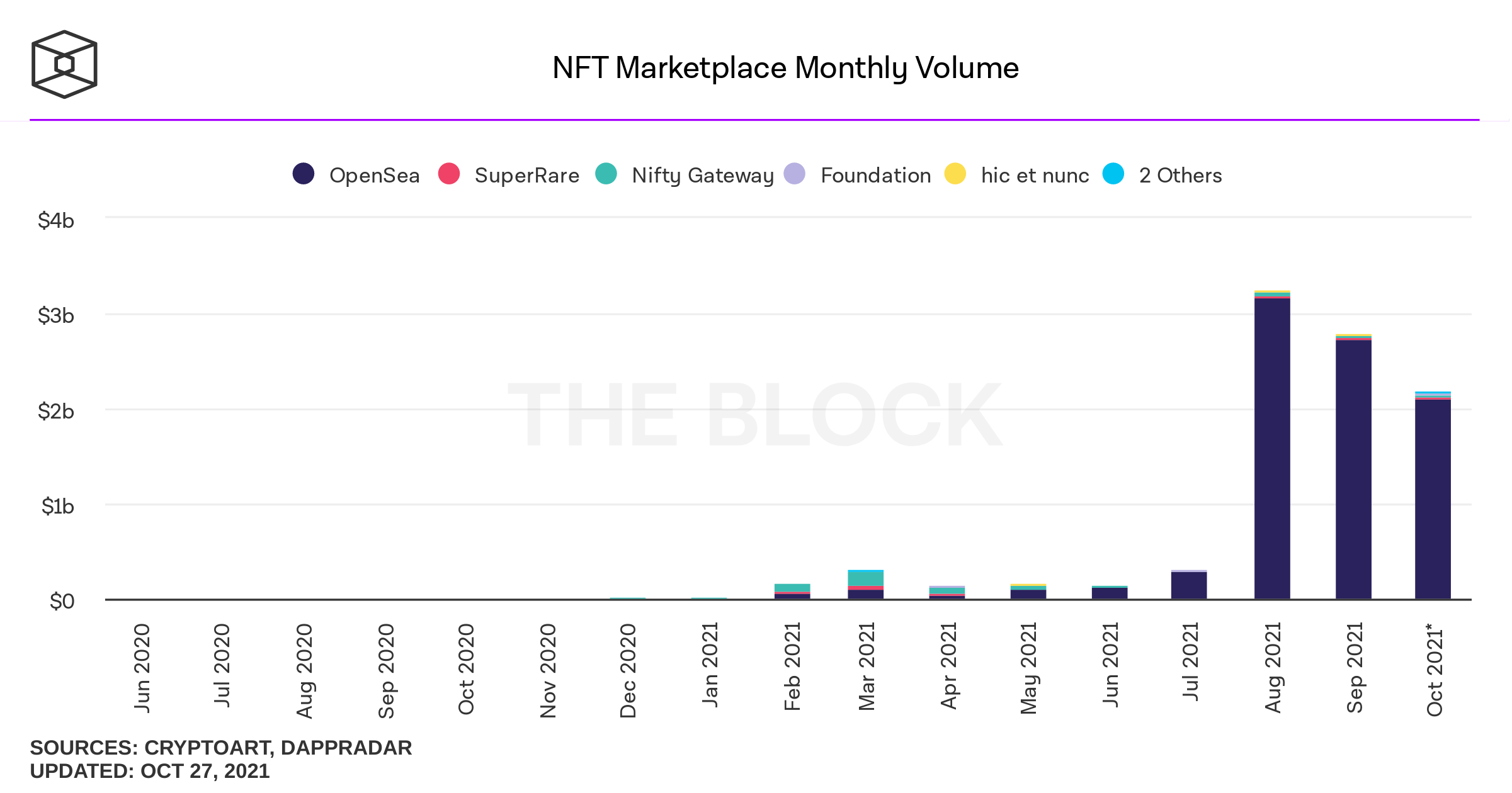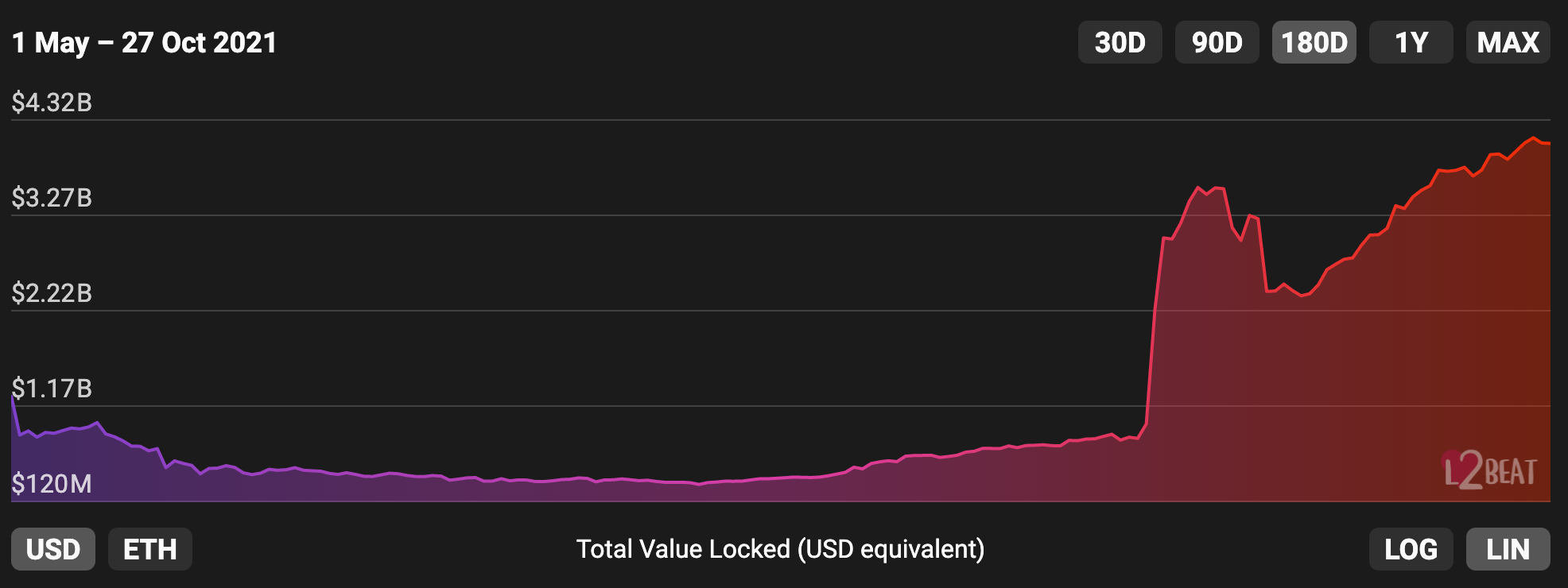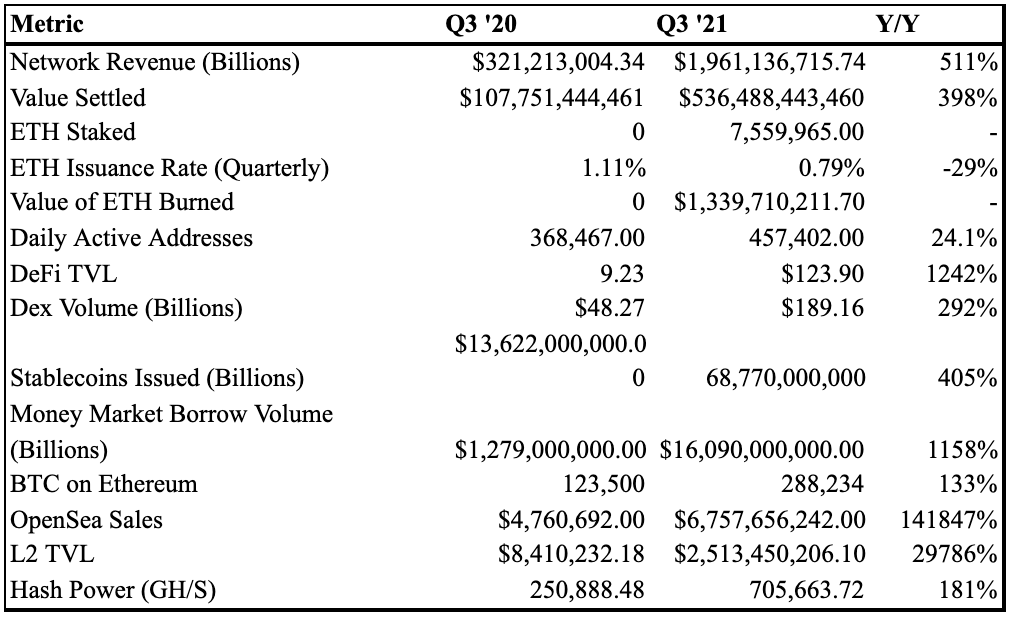Dear Bankless Nation,
Ethereum’s growth over the past year has been incredible.
Think about this…
- Last year NFTs were just valueless jpegs. Now they’re cultural icons.
- Value locked in DeFi was sitting in the low billions. Now there’s more value locked than the market cap of most banks.
- EIP 1559 was still a concept. Now billions of dollars in ETH have been burned.
- The Merge was a distant dream. Now it’s in the final stages of testing.
- Ultra Sound Money didn’t exist. Now it’s the driving narrative for Ethereum.
- DEXs couldn’t compete with centralized exchanges. Now they surpass them.
- Layer 2s had no adoption. Now there are billions of dollars of activity.
Ethereum has grown a lot over the past year.
Ben has the numbers to prove it.
If Ethereum had a quarterly earning report it might look something like this…
- RSA
P.S. Bankless DAO’s new project DAOPunks goes live this week. Pre-sale minting for Bankless DAO members begins tomorrow. Public minting opens on the 30th! 👀
Below is a quarterly report for Ethereum, the world’s largest smart contract platform, for Q3 2021 ending on September 30, 2021.
Let’s take a look at the year over year changes….Q3 2021 compared to Q3 last year.
Protocol Results
- Network Revenue increased 511%. The total transaction fees paid from users to miners increased 511% YOY from $321.21 million in Q3 2020 to $1.96 billion in Q3 2021. Of this, $1.34 billion (68.2%) was burned via the implementation of EIP 1559 back in early August.
- Value Settled rose 398%. This represents the amount of transaction value settled on the network, which rose 398% from $107.75 billion in Q3 2020 to $536.48 billion in Q3 2021.
- Daily Active Addresses grew 24.1%. This is an estimate of the number of daily users on the network, which grew 24.1% YOY from 368,467 addresses in Q3 2020 to 457,402 in Q3 2021.
- Hash Rate grew 181%. The amount of computing power dedicated to securing the Ethereum network via Proof of Work rose from 250,888 GH/S in Q3 2020 to 705,663 GH/S in Q3 2021, resulting in a 181% YOY increase.
- ETH Issuance Rate fell 29%. The rate of expansion of the ETH supply over the course of the quarter fell from 1.11% in Q3 2020 to 0.79% in Q3 2021, a 29% YOY decrease.
Ecosystem Results
- Total Value Locked in DeFi increased 1,242%. The cumulative value of all assets deposited into decentralized finance protocols increased from $9.23 billion in Q3 2020 to $123.90 billion in Q3 2021, representing a meteoric increase of 1,242% YOY.
- Total DEX Volumes rose 242%. This consists of all trading volume on decentralized exchanges. It rose 242% YOY from $48.27 billion in Q3 2020 to $189.16 billion in Q4 2021.
- Total Outstanding Debt increased 1,158%. This highlights the amount of borrowed assets on decentralized money markets like Compound and Aave, which grew from $1.27 billion in Q3 2020 to $16.09 billion in Q3 2021, an 1,158% annualized increase.
- Stablecoins Issuance jumped 405%. The quantity of “big three” stablecoins issued on the network during the quarter (USDT, USDC, and DAI) rose 405% YOY from $13.62 billion in Q3 2020 to $68.77 billion.
- BTC on Ethereum climbed 133%. This represents the total amount of Bitcoin tokenized on Ethereum, increasing 133% from 123,500 in Q3 2020 to 288,234 in Q3 2021.
- OpenSea Sales mooned 141,847%. This measures the trading volume on the leading NFT marketplace, which grew from $4.76 million in Q3 2020 to $6.57 billion in Q3 2021, a 141,847% increase.
- TVL on L2 rose 29,786%. This represents the amount of value locked in layer 2 scaling solutions, which rose 29,786% YOY from $8.41 million in Q3 2020 to $2.51 billion in Q3 2021.
Key Highlights
EIP-1559
EIP-1559, which marked one of the most significant changes to Ethereum in the protocol's history, was implemented as a part of the London network upgrade on August 5th, 2021.
In short, the upgrade restructured Ethereum’s fee market from a first-price auction model to one where users pay a fixed fee (know as the base fee) along with a priority fee (know as the tip). With that, the most anticipated change brought with EIP 1559 was the introduction of fee burning.
Rather than fees being paid directly to miners or validators, this mechanism burns the base fee, permanently removing the ETH from the circulating supply. As referenced above, this resulted in $1.33 billion worth of ETH burned since its implementation a month into Q3.
NFT Mania
One of the quarter’s defining moments was the explosion of activity in the NFT market.
Catalyzed by an initial rise in the price of Cryptopunks, the most valuable collectibles collection by floor price, which saw its cumulative sales volume top $1 billion, the entire NFT market experienced parabolic growth.

As discussed above, volumes on OpenSea rose 141,847% YOY in Q3 to more than $6.75 billion, generating north of $162.7 million in revenue for the platform.
Other NFT collections also saw a substantial increase in their valuations. A prime example was Fidenza from Art Blocks, a generative art collection, which are now fetching for more than $3.3M on the open market. The explosion of NFT mints proved to be a leading cause of elevated gas prices, with spikes reaching as high as 7,300 gwei as seen during the launch of The Sevens collection.
Along with explosive sales metrics, NFTs experienced an increase cultural relevance in society. Celebrities such as Jay-Z, Odell Beckham Jr., and Stephen Curry all saw themselves change their profile picture to these NFT collectibles. Companies also began to adopt the technology, with firms like TikTok announcing the launch of an NFT collection on the Immutable X network, while Visa announced the purchase of a Cryptopunk.
Layer 2 Adoption
The last major highlight in Q3 was the significant progress made in the layer 2 (L2) sector. Most commonly taking the form of optimistic or zero-knowledge (ZK) rollups, L2s help scale Ethereum by increasing transaction throughput and reducing fees while simultaneously inheriting the security of L1.
Two major milestones on this front came with the launch of Optimistic Ethereum’s Alpha launch in July and Arbitrum One’s Mainnet alpha in August. Both built on optimistic rollup technology, the two networks experienced significant growth. For reference, TVL on Optimism currently sits at $271 million while Arbitrum holds $2.41 billion worth of assets.
It’s worth noting that while both networks boast deployments from major DeFi protocols, Arbitrum is permissionless for new protocols to launch and build on, compared to Optimism where they must be whitelisted. As a result, Arbitrum has seen a substantially greater adoption rate than its main competitor, Optimsim. This was initially catalyzed by the Arbinyan yield farm going live on September 13, which quickly accumulated north of $1.5 billion in value in under 48 hours as DeFi degens rushed into the protocol looking to soak up the high yields.

Another significant sign of the growing adoption of L2s was the growth of dYdX. A decentralized exchange for trading perpetual contracts built on StarkWare’s zk-rollup technology (StarkEx), the protocol experienced meteoric growth after the launch of its governance token, which featured a range of enticing incentive programs for users.
The protocol at one point saw daily volumes climb as high as $9.7 billion, surpassing centralized exchanges such as Coinbase.
Future Outlook
There are significant catalysts for Ethereum’s growth in Q4 2021 and into FY 2022.
The most significant is “The Merge” where the network will be changing consensus mechanisms from Proof Of Work (PoW) to Proof Of Stake (PoS). The upgrade will phase out energy-intensive hardware miners in favor of validators, where the network is secured by capital in the form of ETH instead of computing power. As a result, this will allow Ethereum to significantly reduce its energy consumption and remove miners as stakeholders in the network.
In addition, The Merge is projected to cause a substantial reduction in the future issuance of ETH. When combined with the burning from EIP-1559, this could lead to a deflationary ETH, dubbed “ultra sound money” by the community.
Another upcoming protocol-level catalyst comes in the form of sharding, or a change in the architecture of the network from one monolithic chain to that of 64 individual shards which can each process transactions. Although the timeline for the upgrade is unclear, sharding, combined with the increased adoption of L2 solutions, will help Ethereum complete its transition to that of a modular blockchain.
📚 Read David’s article on Ultra Scalable Ethereum to get a deep understanding on the value of a modular blockchain versus a monolithic one.
At the application layer, a catalyst for Ethereum DeFi’s continued growth comes from the rise of “DeFi 2.0.” A new wave of protocols that place an emphasis on capital efficiency, liquidity management, and multi-network deployments stand at the forefront of Ethereum innovation. These new protocols, along with the increased adoption and development of L2, should combine to help onboard a tsunami of new users to the Ethereum ecosystem.
There are several non-DeFi catalysts on the horizon for Ethereum as well. This includes the increasing adoption and financialization of NFTs, such as through offerings by companies like GameStop and through protocols like fractional art, as well as the onboarding of new users via crypto gaming.
This may be through the continued growth of play-to-earn games like Axie Infinity, as well as the launch of new titles like Illuvium on the Immutable X network.
Results Summary

Inspiring Quotes from Q3
“The biggest, clearest bet of all is Ethereum.” - Raoul Pal
“Ethereum development is reaching a new level of maturity. The gap between where Ethereum currently stands and where it is going is rapidly shrinking.” – David Hoffman
“We are going to make a run at changing the arc of history” – @punk6529
“If you bet against Ethereum DeFi, u ngmi” – Ben Giove
About Ethereum
Ethereum is an open-source, decentralized blockchain network. Ethereum is a technology that's home to digital money, global payments, and applications. The community has built a booming digital economy, bold new ways for creators to earn online, and so much more. It's open to everyone, wherever you are in the world – all you need is the internet (Taken from Ethereum.org website.)
About This Release
This release is not a release of Ethereum or the Ethereum foundation. The piece is inspired by James Wang’s “Ethereum Announces First Quarter 2021 Results.”
Action steps
- 🔥 Evaluate Ethereum’s Q3 results
- 📚 Read Ultra Scalable Ethereum to understand future catalysts in 2022
